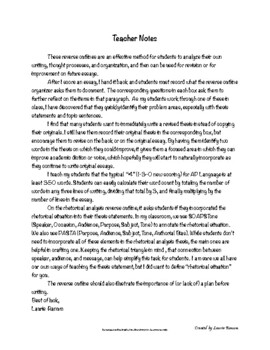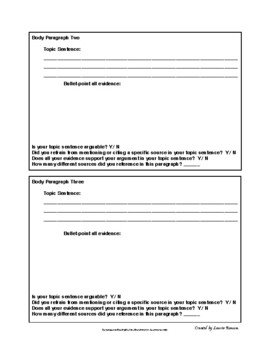Reverse Outlines: Synthesis, Argument, and RA Essays | AP Lang | PDF & Digital
- Zip
- Easel Activity
Also included in
- This Rhetorical Analysis MEGA BUNDLE of Materials compiles the following fourteen rhetorical analysis products and is perfect for new AP Language and Composition teachers, an "AP for ALL" approach, and pre-AP Lang/Honors English classrooms:* Introduction to Rhetorical Analysis via Advertisements UNIPrice $50.00Original Price $66.50Save $16.50
- This organizational BUNDLE includes the following four products:1. Rhetorical Analysis Line of Reasoning Graphic Organizers | AP LangThis student-friendly set of rhetorical analysis planners will aid students in developing a sound line of reasoning for their rhetorical analysis essays.Perfect for scPrice $19.00Original Price $22.00Save $3.00
Description
This product includes three, three-page reverse outline organizers designed for student essay analysis and reflection for synthesis, argument, and rhetorical analysis.
These reverse outlines are an effective method for students to analyze their own writing, thought processes, and organization, and then can be used for revision or for improvement on future essays. They could also be effective in illustrating what another author does in his/her text. A super resource for emphasizing line of reasoning.
After I score an essay, I hand it back and students must record what the reverse outline organizer asks them to document. The corresponding questions in each box ask them to further reflect on the items in that paragraph. As my students work through one of these in class, I have discovered that they quickly identify their problem areas, especially with thesis statements and topic sentences.
The reverse outline should also illustrate the importance of (or lack of) a plan before writing!
Digital Activity already created for you to easily assign to your students via Google Classroom. Via the Digital Activity Interactive Layer, you also have the option to customize and create annotations and additional directions to this Digital Activity for your specific needs.
Please open the preview to read the complete Teacher Notes!
------------------------------------------------------------------------------------------------
You might be interested in some of my other AP Lang and Comp materials:
* Argument Line of Reasoning Graphic Organizers | AP Lang
* Rhetorical Analysis Line of Reasoning Graphic Organizers | AP Lang
* Synthesis Line of Reasoning Graphic Organizer | AP Lang & Pre-AP English
* Current Events: Editorials; AP Language and Composition
* AP Lang and Comp Syntactical Imitations for Unbroken; Syntax
* In Cold Blood - Syntactical Imitations; AP Lang and Comp; Syntax
* AP Language Nonfiction Book Presentation; "Sell Your Book" AP Lang
* AP Language Independent Nonfiction Book Written Argument - Essay; AP Lang
* AP Language/AP Lang Current Events Synthesis; Current Events; Synthesis Essay
* SOAPSTONE Posters & Powerpoint; AP, Pre-AP,
* Rhetorical Analysis Tips Handout; AP Lang and Comp
* Rhetorical Analysis Body Paragraph Organizer; AP Language and Composition
* The Things They Carried - Syntactical Imitations; AP Lang and Comp; Syntax
* The Glass Castle BUNDLE: Quote Response, Argument Prompts, Syntactical Imitation








